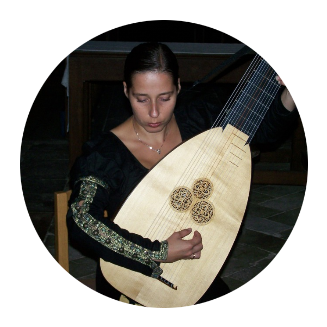Lute
Instruments
Lute can refer generally to any plucked string instrument with a neck (either fretted or unfretted) and a deep round back, or more specifically to an instrument from the family of European lutes.
The European lute and the modern Near-Eastern oud both descend from a common ancestor via diverging evolutionary paths. The lute is used in a great variety of instrumental music from the early renaissance to the late baroque eras. It is also an accompanying instrument, especially in vocal works, often realizing a basso continuo or playing a written-out accompaniment.
The words "lute" and "oud" derive from Arabic al'ud (literally "the wood"). Recent research by Eckhard Neubauer suggests that 'ud may in turn be an Arabized version of the Persian name rud, which meant "string," "stringed instrument," or "lute". Gianfranco Lotti suggests that the "wood" appellation originally carried derogatory connotations, because of proscriptions of all instrumental music in early Islam.
The origins of the lute are obscure, and organologists disagree about the very definition of a lute. The highly influential organologist Curt Sachs distinguished between the "long-necked lute" (Langhalslaute) and the short-necked variety: both referred to chordophones with a neck as distinguished from harps and psalteries. Smith and others argue that the long-necked variety should not be called lute at all, since it existed for at least a millennium before the appearance of the short-necked instrument that eventually evolved into what is now known as the lute, nor was it ever called a lute before the 20th century.
Various types of necked chordophones were in use in ancient Egyptian in the Middle Kingdom, Hittite, Greek, Roman, Bulgar, Turkic, Indian, Chinese, Armenian/Cilician cultures. The Lute developed its familiar forms as Barbat in Persia, Armenia, and Byzantium beginning in the early 7th century. These instruments often had bodies covered with animal skin, and it is unknown exactly when it became replaced with a wooden soundboard.
As early as the 6th century the Bulgars brought the short-necked variety of the instrument called Kobuz to the Balkans, and in the 9th century Moors brought the Oud to Spain. The long-necked Pandora/Quitra had been common Mediterranean lute previously. The Quitra didn't become extinct however, but continued its evolution, its descendants being Chitarra Italiana, Chitarrone and Colascione, aside from the still surviving Kuitra of Algiers and Morocco.
In about the year 1500 many Spanish, Catalan and Portuguese lutenists adopted vihuela de mano, a viol-shaped instrument tuned like the lute, but both instruments continued in coexistence. This instrument also found its way to parts of Italy that were under Spanish domination (especially Sicily and the papal states under the Borgia pope Alexander VI who brought many Catalan musicians to Italy), where it was known as the viola da mano.
Medieval lutes were 4- or 5-course instruments, plucked using a quill for a plectrum. There were several sizes, and by the end of the Renaissance, seven different sizes (up to the great octave bass) are documented. Song accompaniment was probably the lute's primary function in the Middle Ages, but very little music securely attributable to the lute survives from the era before 1500. Medieval and early-Renaissance song accompaniments were probably mostly improvised, hence the lack of written records.
In the last few decades of the 15th century, in order to play Renaissance polyphony on a single instrument, lutenists gradually abandoned the quill in favor of plucking the instrument with the fingertips. The number of courses grew to six and beyond. The lute was the premier solo instrument of the 16th century, but continued to be used to accompany singers as well.
By the end of the Renaissance the number of courses had grown to ten, and during the Baroque era the number continued to grow until it reached 14 (and occasionally as many as 19). These instruments, with up to 26-35 strings, required innovations in the structure of the lute. At the end of the lute's evolution the archlute, theorbo and torban had long extensions attached to the main tuning head in order to provide a greater resonating length for the bass strings, and since human fingers are not long enough to stop strings across a neck wide enough to hold 14 courses, the bass strings were placed outside the fretboard, and were played "open", i.e. without fretting/stopping them with the left hand.
Over the course of the Baroque era the lute was increasingly relegated to the continuo accompaniment, and was eventually superseded in that role by keyboard instruments. The lute almost fell out of use after 1800. Some sorts of lute were still used for some time in Germany, Sweden, Ukraine.

